Nabro eruption subdued but ongoing 21 June 2011
Posted by admin in activity reports, Africa, Eritrea, eruptions, Ethiopia, Nabro.trackback
Above. Nabro eruption SO2 emissions 19 June 2011 (NASA/Aura/OMI).
Overall the eruption of Nabro volcano in Eritrea seems to have been going through a quieter phase over the past two days, with rather small plumes (or none at all) visible in satellite images and little evidence of further explosive activity. Toulouse VAAC issued two advisories yesterday, the first at 1200 UTC reported ‘eruption mainly producing SO2’ with a small ash cloud at FL180 (18,000 feet/5,500 metres altitude) extending to the WSW/SW of the volcano, and the second at 1800 UTC reporting ‘eruption ongoing’ with no identifable ash emission: ‘only SO2 detected since 1230Z’. The sulphur dioxide emissions from Nabro have been on a very large scale: with reference to data from last week NASA reported that ‘On June 13, OMI captured high SO2 concentrations – exceeding thousands of Dobson units – from the eruption of Nabro (Eritrea) on June 12th. Total tonnage is estimated to exceed 1Tg’. There have of course been significant further SO2 emissions from Nabro since that report was written on 16 June. A gallery of Aura/OMI SO2 data for Afar showing the size and movement of the SO2 plume from Nabro can be viewed at NASA’s Goddard Space Flight Center global SO2 monitoring site. The image at the top of the post shows the SO2 plume detected by Aura’s OMI on 19 June 2011.
NASA satellite images from yesterday show the presence of a small plume over the seat of the eruption with no significant downwind emissions cloud visible. Below are images from Aqua (top) and Terra (bottom): in each case click on the image to go to the original at the NASA Rapidfire site.
Above. Nabro volcano, Eritrea, captured by NASA’s Aqua satellite on 20 June 2011, 1050Z. Scale: 1px = 500m.
Above. Nabro volcano, Eritrea, captured by NASA’s Terra satellite on 20 June 2011, 0750Z. Scale: 1px = 500m.
A dark patch is visible on the surface to the SW of the volcano. The atmosphere is murky and it is difficult to see precisely what this is: it looks too fuzzy at the edges and too brown in colour to be a lava flow. Burnt vegetation? An ash deposit? Below is a close-up from the Terra image:
Above. Nabro volcano, Eritrea, captured by NASA’s Terra satellite on 20 June 2011, 0750Z. Scale: 1px = 250m.
The human impact of the eruption is starting to become clearer, althouth reports from the area affected by the Nabro eruption have been hard to come by: even in this modern age communications can be difficult in this part of the world, the political character of the region tends not to encourage the free spread of information, and enduring tension between Ethiopia and Eritrea does not help. However, an article in the Ethiopian business newspaper Addis Fortune published yesterday (although the date ’12 June 2011′ confusingly appears at the top), ‘Eritrean volcano erupts economic mayhem for Ethiopia’, gives some idea of the problems the eruption has been causing across the area: flight delays and cancellations, potential health problems, and the poisoning by SO2 of local salt deposits formally exploited for consumption. The report also refers to ‘small eruptions in Afambo and Sireru areas’ as well as ‘the major eruption at Nabro’, although it is not clear precisely what’s being described here: earthquake activity, perhaps, rather than ‘eruptions’. The BBC, meanwhile, reports on appeals from aid organizations for help for the local people in Ethiopia: the inhabitants of villages in the Biddu region near the border ‘have been left without food and traditional springs and streams have been polluted’. Teshome Assefa of Save the Children tells the BBC, ‘Many community members and especially children are reported sick and in desperate need of medical attention’. It’s good to see the BBC reporting this, not so good that more than a week into the eruption they still haven’t got the name of the volcano right (‘Dubbi’ again). [Update: the BBC has corrected its report: Nabro. Thank you.]
In Eritrea itself official news on the eruption has been sparse. A brief bulletin was issued by the Eritrean Government Ministry of Information at the beginning of the eruption stating that there had been no loss of life or any other ill-effects. It seems, however, that there have been evacuations from the affected area within Eritrea, according to a further brief announcement made on 16 June:
Assab, June 16, 2011- The inhabitants of Afambo, Nebro and Sireru have disclosed that they have been moved to a safer location. Pointing out that there were occasional quakes in their areas, the inhabitants thanked the government for the fast relocation after the eruption, as a result of which there were no causalities [sic]. It is to be recalled that the eruption of June 12th around the areas of Afambo, Nebro and Sireru released large quantities of dust and smoke and the quake of 5.7 Richter it caused was felt in our region.
On the subject of earthquakes, the staff at the Observatoire Géophysique d’Arta (OGA) in Djibouti are clearly working very hard to keep track of the seismic activity in their northern neighbour and are providing the best coverage they can via their website. Today a strapline on their front page reports a decrease in tremors, with ‘few earthquakes on the Nabro volcano site’, but there are no details as yet.
News
Eritrean volcano erupts economic mayhem for Ethiopia – Addis Fortune, 20 June 2011
Eritrea volcano ash hits Ethiopia villagers – BBC News, 20 June 2011
Information
Global Volcanism Program: Nabro – summary information for Nabro (0201-101)
Comments
Sorry comments are closed for this entry















Thank you for the update. It’s a fascinating event and there is such a lack of imagery!
I do have a hard time believing that the Eritrean government has actually done anything official to aid the villagers living around the volcano. I suspect it’s just PR. I’m cynical.
Thanks for the comment, Maria. I tend to concur with your cynical view.
I wonder how big this sulfer plume is compared to Pinatubo in 1991.
Maria, What makes you add that comment about the government of Eritrea?
It is irresponsible of you to say “just PR”.